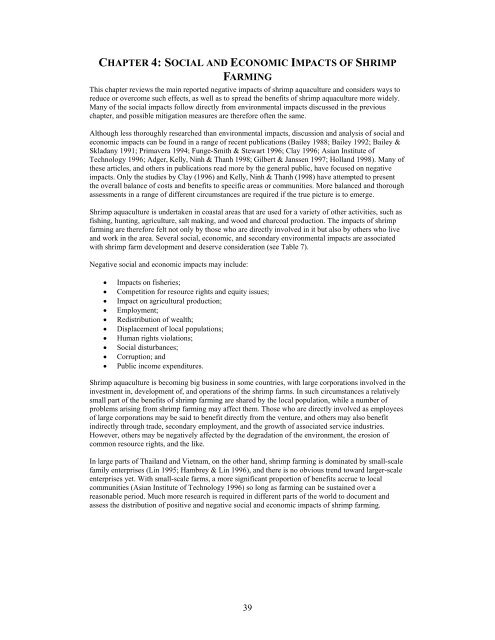Shrimp Farming and the Environment - Library
Shrimp Farming and the Environment - Library
Shrimp Farming and the Environment - Library
You also want an ePaper? Increase the reach of your titles
YUMPU automatically turns print PDFs into web optimized ePapers that Google loves.
CHAPTER 4: SOCIAL AND ECONOMIC IMPACTS OF SHRIMPFARMINGThis chapter reviews <strong>the</strong> main reported negative impacts of shrimp aquaculture <strong>and</strong> considers ways toreduce or overcome such effects, as well as to spread <strong>the</strong> benefits of shrimp aquaculture more widely.Many of <strong>the</strong> social impacts follow directly from environmental impacts discussed in <strong>the</strong> previouschapter, <strong>and</strong> possible mitigation measures are <strong>the</strong>refore often <strong>the</strong> same.Although less thoroughly researched than environmental impacts, discussion <strong>and</strong> analysis of social <strong>and</strong>economic impacts can be found in a range of recent publications (Bailey 1988; Bailey 1992; Bailey &Skladany 1991; Primavera 1994; Funge-Smith & Stewart 1996; Clay 1996; Asian Institute ofTechnology 1996; Adger, Kelly, Ninh & Thanh 1998; Gilbert & Janssen 1997; Holl<strong>and</strong> 1998). Many of<strong>the</strong>se articles, <strong>and</strong> o<strong>the</strong>rs in publications read more by <strong>the</strong> general public, have focused on negativeimpacts. Only <strong>the</strong> studies by Clay (1996) <strong>and</strong> Kelly, Ninh & Thanh (1998) have attempted to present<strong>the</strong> overall balance of costs <strong>and</strong> benefits to specific areas or communities. More balanced <strong>and</strong> thoroughassessments in a range of different circumstances are required if <strong>the</strong> true picture is to emerge.<strong>Shrimp</strong> aquaculture is undertaken in coastal areas that are used for a variety of o<strong>the</strong>r activities, such asfishing, hunting, agriculture, salt making, <strong>and</strong> wood <strong>and</strong> charcoal production. The impacts of shrimpfarming are <strong>the</strong>refore felt not only by those who are directly involved in it but also by o<strong>the</strong>rs who live<strong>and</strong> work in <strong>the</strong> area. Several social, economic, <strong>and</strong> secondary environmental impacts are associatedwith shrimp farm development <strong>and</strong> deserve consideration (see Table 7).Negative social <strong>and</strong> economic impacts may include:• Impacts on fisheries;• Competition for resource rights <strong>and</strong> equity issues;• Impact on agricultural production;• Employment;• Redistribution of wealth;• Displacement of local populations;• Human rights violations;• Social disturbances;• Corruption; <strong>and</strong>• Public income expenditures.<strong>Shrimp</strong> aquaculture is becoming big business in some countries, with large corporations involved in <strong>the</strong>investment in, development of, <strong>and</strong> operations of <strong>the</strong> shrimp farms. In such circumstances a relativelysmall part of <strong>the</strong> benefits of shrimp farming are shared by <strong>the</strong> local population, while a number ofproblems arising from shrimp farming may affect <strong>the</strong>m. Those who are directly involved as employeesof large corporations may be said to benefit directly from <strong>the</strong> venture, <strong>and</strong> o<strong>the</strong>rs may also benefitindirectly through trade, secondary employment, <strong>and</strong> <strong>the</strong> growth of associated service industries.However, o<strong>the</strong>rs may be negatively affected by <strong>the</strong> degradation of <strong>the</strong> environment, <strong>the</strong> erosion ofcommon resource rights, <strong>and</strong> <strong>the</strong> like.In large parts of Thail<strong>and</strong> <strong>and</strong> Vietnam, on <strong>the</strong> o<strong>the</strong>r h<strong>and</strong>, shrimp farming is dominated by small-scalefamily enterprises (Lin 1995; Hambrey & Lin 1996), <strong>and</strong> <strong>the</strong>re is no obvious trend toward larger-scaleenterprises yet. With small-scale farms, a more significant proportion of benefits accrue to localcommunities (Asian Institute of Technology 1996) so long as farming can be sustained over areasonable period. Much more research is required in different parts of <strong>the</strong> world to document <strong>and</strong>assess <strong>the</strong> distribution of positive <strong>and</strong> negative social <strong>and</strong> economic impacts of shrimp farming.39
















